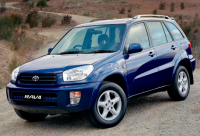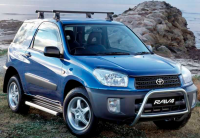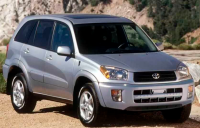When it comes to choosing a parkette, a large proportion of would-be car owners are thinking of the 2000-2006 Toyota RAV4. This is despite the fact that the model has the highest price tag among used cars in its class. But demand for it has been consistently high, including for cars with a background, for many years.
Pros and cons of the 2000-2006 Toyota RAV4
The 2000-2006 Toyota RAV4 also has a lot of merits, such as sharp steering and polished handling, always-on all-wheel drive and a soft-shift automatic gearbox. It also has an acceptable degree of maintainability to its credit, and good prices on parts.

There are, of course, some disadvantages, but not so many. The first of them is a small amount of free space in saloon, that's why it is chosen mainly by women. Irrespective of responses of male owners, the RAV 4 is exclusively female parkettes.
The second disadvantage is the presence in the first ten most popular models among thieves. Besides, some too picky drivers will note mediocre sound insulation of the interior. But in general it is acceptable for a budget pickup.
Under normal operation the unexpected breakdowns of Toyota RAV4 2000-2006 models are practically excluded. But much of the space on the sales floor is taken up by "killed" or completely run-down cars. This leads to the fact that carrying out a diagnosis before buying is not just desirable, it becomes essential.
Cars that are imported from America and Canada also have significant market share, but many of them are simply junk. There are only three models out of ten presented in good quality. But don't give up on them beforehand, it is better to make a thorough diagnostics.
Toyota RAV4 2000-2006 engines, transmission
The 1.8-litre engine modifications are very rare in our country. It is absolutely not surprising, as for a car with an all-wheel drive the more powerful motor will be optimum. 2 litres will do just fine, as 2.4-liter versions are also rare.

In use, these engines have shown a high degree of reliability. Only the ignition coils and the oxygen sensor have caused complaints. Costs of chain adjustment will be needed only after a mileage of 200 thousand kilometres.
The owners of this automobile should consider that even taking into account its appearance, it is a passenger car, with light transmission and practically absent protection of aggregates, and there is no downshift gear.
So off-roading can result in long and expensive repairs. With careful use of the car, there will be no problems even after the run of more than 200 thousand km.
More: Third-generation Toyota RAV4 after two restylings
Toyota RAV4 2000-2006 Toyota RAV4 body and suspension
The second-generation RAV4 was produced with two body options - with three and five doors, of which the first in the European market was a great rarity. Its bodywork has stood up well to the peculiarities of roads in Europe, and even the electrical equipment is not as affected by salt damage as on many other cars of the same class.
The suspension is fairly strong too, except when it's used for heavy off-roading, which it isn't. Most of the suspension parts have a service life of 150,000-200,000 kilometres, which is much better than the European-style parkettes.
After driving approximately 100 thousand kilometres, the brake discs and shock absorbers need replacing. The stabiliser struts and bushings will need to be replaced somewhat earlier - after 50,000 kilometres.
Read also: 2016 Toyota Land Cruiser 200 review
Another unpleasant feature of this car model is the operation of spark plugs for 15-20 thousand kilometres, which is not much.
Expert summary
The 2000-2006 Toyota RAV4 parkettes have been found to be near-perfect, reliable and unpretentious. But every spoon of honey has its own spoon of tar, which has become a high degree of attention from the thieves. That means higher insurance premiums.




